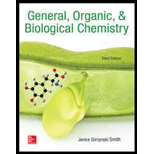
(a)
Interpretation:
The product formed when p-dichlorobenzene is treated with
Concept Introduction:
The electrophilic substitution reactions are the most common reactions of
These reactions occur in the presence of certain catalyst like
(b)
Interpretation:
The product formed when p-dichlorobenzene is treated with
Concept Introduction:
The electrophilic substitution reactions are the most common reactions of aromatic compounds. It involves the substitution of one of the H atom of aromatic ring with electrophile. It leads to the formation of arenium ion as an intermediate which immediately loses hydrogen ion to form the substituted product.
These reactions occur in the presence of certain catalyst like
(c)
Interpretation:
The product formed when p-dichlorobenzene is treated with
Concept Introduction:
The electrophilic substitution reactions are the most common reactions of aromatic compounds. It involves the substitution of one of the H atom of aromatic ring with electrophile. It leads to the formation of arenium ion as an intermediate which immediately loses hydrogen ion to form the substituted product.
These reactions occur in the presence of certain catalyst like
Want to see the full answer?
Check out a sample textbook solution
Chapter 13 Solutions
General, Organic, & Biological Chemistry
- The foul odor of rancid butter is caused by butyric acid, CH3CH2CH2CO2H. (a) Draw the Lewis structure and determine the oxidation number and hybridization for each carbon atom in the molecule. (b) The esters formed from butyric acid are pleasant-smelling compounds found in fruits and used in perfumes. Draw the Lewis structure for the ester formed from the reaction of butyric acid with 2-propanol.arrow_forwardIsooctane is the common name of the isomer of C8H18 used as the standard of 100 for the gasoline octane rating: (a) What is the IUPAC name for the compound? (b) Name the other isomers that contain a five-carbon chain with three methyl substituents.arrow_forwardWhen the conjugate acid of aniline, C6H5NH3+, reacts with the acetate ion, the following reaction takes place: C6H5NH3+(aq)+CH3COO(aq)C6H5NH2(aq)+CH3COOH(aq) If Kafor C6H5NH3+ is 1.35105 and Kafor CH3COOH is 1.86105 , what is K for the reaction?arrow_forward
- 3-Methyl-2-hexenoic acid (mixture of E and Z isomers) has been identified as the substance responsible for the odor of human sweat. Synthesize the compound from raw materials that have five carbons or less.arrow_forwardWhen benzene enters the body, it is oxidized to phenol (C 6H 5OH). What is the purpose of this oxidation reaction?arrow_forwardConsider the following test samples: A. heptane D. toluene B. hexane E. benzene C. hexene Which of the test samples will react with conc. H2SO4 ?arrow_forward
- Draw the structure corresponding to each name: a.isobutylbenzene b.o-dichlorobenzene c.cis-1,2-diphenylcyclohexane d.m-bromoaniline e.4-chloro-1,2-diethylbenzene f.3-tert-butyl-2-ethyltoluenearrow_forwardWhat is the reaction product when benzene reacts with CH3CH2Cl to form AlCl3 acting as a catalyst? a) Ethylbenzene b) Different isomers of dichlorobenzene c) Chlorobenzene d) Phenyl aluminumarrow_forward2. a. What is the chemical structure of naphthalene, circle functional groups different than alkane,alkene, alkyne? b. Is it polar or nonpolar? _______________________ c. What is its water solubility in g/L? _________________________arrow_forward
- Draw a structural formula of the product of oxidation of natural rubber by ozone followed by a workup in the presence of (CH3)2S. Name each functional group present in this product.arrow_forward4,4-diethyl-1-methoxy-3methyldecane draw the structurearrow_forwardWhat hydrocarbon with the molecular formula C4H10 forms three monochlorinated products? One is achiral and two are chiral.arrow_forward
 Chemistry: Principles and ReactionsChemistryISBN:9781305079373Author:William L. Masterton, Cecile N. HurleyPublisher:Cengage Learning
Chemistry: Principles and ReactionsChemistryISBN:9781305079373Author:William L. Masterton, Cecile N. HurleyPublisher:Cengage Learning General Chemistry - Standalone book (MindTap Cour...ChemistryISBN:9781305580343Author:Steven D. Gammon, Ebbing, Darrell Ebbing, Steven D., Darrell; Gammon, Darrell Ebbing; Steven D. Gammon, Darrell D.; Gammon, Ebbing; Steven D. Gammon; DarrellPublisher:Cengage Learning
General Chemistry - Standalone book (MindTap Cour...ChemistryISBN:9781305580343Author:Steven D. Gammon, Ebbing, Darrell Ebbing, Steven D., Darrell; Gammon, Darrell Ebbing; Steven D. Gammon, Darrell D.; Gammon, Ebbing; Steven D. Gammon; DarrellPublisher:Cengage Learning Chemistry: Principles and PracticeChemistryISBN:9780534420123Author:Daniel L. Reger, Scott R. Goode, David W. Ball, Edward MercerPublisher:Cengage Learning
Chemistry: Principles and PracticeChemistryISBN:9780534420123Author:Daniel L. Reger, Scott R. Goode, David W. Ball, Edward MercerPublisher:Cengage Learning
 ChemistryChemistryISBN:9781305957404Author:Steven S. Zumdahl, Susan A. Zumdahl, Donald J. DeCostePublisher:Cengage Learning
ChemistryChemistryISBN:9781305957404Author:Steven S. Zumdahl, Susan A. Zumdahl, Donald J. DeCostePublisher:Cengage Learning Chemistry: An Atoms First ApproachChemistryISBN:9781305079243Author:Steven S. Zumdahl, Susan A. ZumdahlPublisher:Cengage Learning
Chemistry: An Atoms First ApproachChemistryISBN:9781305079243Author:Steven S. Zumdahl, Susan A. ZumdahlPublisher:Cengage Learning





